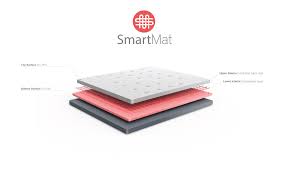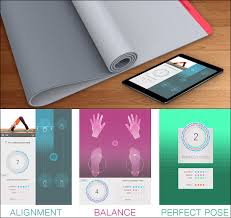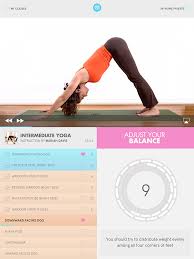SmartMat – quantifying the unquantifiable

SmartMat allows the analytically-minded yogi to quantify yoga poses in the hopes of deepening his or her practice over time.
For those of you who have read some of my previous posts, I’m keeping with the yoga theme. Yoga and Big Data? Seems like an oxymoron, or at least two words that should not appear in one sentence. That’s what I thought, until I came across SmartMat.
 I’m not one for quantifying a spiritual practice, but SmartMat is a really cool idea. In a nutshell, SmartMat is like any other high-quality yoga mat, except that it’s embedded with pressurized sensors that measure and provide feedback on the user’s balance and alignment for 62 yoga poses. The mat functions along with a smartphone app, which provides the yogi with a heat map and three different “modes” of instruction that allow the student to gather analytics during their yoga practice at home or in live classes.
I’m not one for quantifying a spiritual practice, but SmartMat is a really cool idea. In a nutshell, SmartMat is like any other high-quality yoga mat, except that it’s embedded with pressurized sensors that measure and provide feedback on the user’s balance and alignment for 62 yoga poses. The mat functions along with a smartphone app, which provides the yogi with a heat map and three different “modes” of instruction that allow the student to gather analytics during their yoga practice at home or in live classes.
 What’s so interesting and relevant about the technology is that it “learns” and improves over time: the more a user practices on the mat, the better the software behind the mat becomes at recognizing when the user’s alignment and balance are correct, and the better the resulting feedback.
What’s so interesting and relevant about the technology is that it “learns” and improves over time: the more a user practices on the mat, the better the software behind the mat becomes at recognizing when the user’s alignment and balance are correct, and the better the resulting feedback.
The hardware is very impressive as well – the mat looks and feels like a regular yoga mat, with the slight exception of a dongle that extends outside of the mat to attach to the user’s iPhone, as well as an iPhone stand to make the real-time feedback easier to see and follow. Oh, and the developers had to figure out how to insert delicate sensors between the two PVC layers of the mat, which are sensitive enough to provide accurate and useful feedback to the user, but able to take a beating in a 110 degree hot yoga session.
 Now, the question is: who cares? Why would any yogi use this when traditionally students learn via a live teacher, hands-on assists and years of repetition? Based on what I’ve gathered, SmartMat sees a couple of reasons:
Now, the question is: who cares? Why would any yogi use this when traditionally students learn via a live teacher, hands-on assists and years of repetition? Based on what I’ve gathered, SmartMat sees a couple of reasons:
- By making yoga into a science, it unlocks the practice for many who may have shied away from the New Age-y aspects of yoga. The price tag is pretty high ($497 retail and $297 for those who purchased via SmartMat’s Indiegogo campaign), so the initial adopters will likely be wealthy, analytical-minded yogis, but if in the hands of yoga teachers, physical therapists and other health practitioners, it could provide access to those who normally would not consider it. I believe the key is the SmartMat’s ability to learn the yogi’s individual body and improve over time. Seeing one’s progress is highly motivating and would allow the user to develop a greater attachment to the product.
- People are willing to pay a high price. On their website, SmartMat lists scaling up to manufacture profitably as a major challenge. However, they claim that they know what their unit cost is and are ready to deliver. Given the popularity of the FitBit, this trend could take off along with the broader growth in the number of adults practicing yoga in the U.S., which by some estimates results in almost $10 billion in yoga-related sales.
 According to the founders, the SmartMat started as a question, namely, why hasn’t this been done before? The founders poured over $100,000 of their own money into determining if the idea was viable at a specific variable cost, price and delivery date prior to launching on Indiegogo. Their initial R&D proved promising, and they now are almost 300% over their goal on Indiegogo, with over $350,000 raised as of this week.
According to the founders, the SmartMat started as a question, namely, why hasn’t this been done before? The founders poured over $100,000 of their own money into determining if the idea was viable at a specific variable cost, price and delivery date prior to launching on Indiegogo. Their initial R&D proved promising, and they now are almost 300% over their goal on Indiegogo, with over $350,000 raised as of this week.
Despite these benefits and the incredible amount of sweat and tears that went into this product, I see some issues:
- I’m a little torn on the value creation pitch listed above. How much value are they really creating? I would imagine the type of person that would purchase this product is already a highly-advanced yoga student or is a FitBit-ish enthusiast who will purchase the mat, use it once or twice, and then let it sit in the closet. Without a strong yoga practice already in place, the mat seems superfluous (as does the FitBit, in my opinion). If we consider generation of money creating value, then sure, it will create value by appealing to the wealthiest yogis. However, if the goal is to broaden access, I think that’s like saying Tesla is broadening access to electric cars. Maybe it will down the road (it’s working on a mass produced car, I know…) but for now it’s a rich man’s luxury.
- To produce this mat at scale, they have to produce a lot, and I’m not sure sufficient demand exists. They don’t have any numbers on their website, but they claim they have to build custom machinery and molds. I’m no machinist, but seems like an expensive proposition and counter-productive to increase the price of admission to yoga.
- Performance risk – will the mat actually work? I’m a little skeptical. The founders claim they calibrated all 62 poses by measuring 20 different yogi’s demonstration of the poses, and using that to find an “average” pose that the SmartMat will guide the user towards. The problem with this is that every person’s body is different, and guiding people towards an average may actually be physically harmful if their bodies are not meant to take certain poses in an “average” way. Yoga is all about exceptions to the rule and modifications. If the SmartMat does not deliver as promised, and users don’t see their yoga practice progressing, word of mouth will work against the startup.
Overall, it’s a cool concept, and it may take a while to catch on. To expand access, maybe SmartMat will end up supplying the technology to health practitioners such as physical therapists and chiropractors, who see yogis from all walks of life.



Whoa, really cool idea! I’m impressed by the hardware capabilities they’ve developed. And I did always find it weird that people “learn” yoga basically by being in a large, crowded room with dozens of other people, without receiving much if any personalized guidance or adjustments from a professional. This seems to help address some of that problem.
It seems like there are many parallels to this product in other kinds of sports – lots of companies are trying to insert sensors into different kinds of equipment, from tennis rackets to soccer balls. I wonder why people are going more for this approach (which is hardware intensive) instead of going for the video analysis approach (which would be more software intensive I imagine). For example, I imagine that there are many things which a yoga mat could sense, but also a realm of metrics that a video of somebody doing yoga could also measure. I also imagine that having a machine analyzing video footage of somebody playing tennis or soccer could also generate a lot of recommendations. With both the “embedded hardware” solution and the “video analysis” solution, the problems that people are trying to solve seem to be 1) collect lots and lots of data points then 2) analyze that data. I wonder if the video solution holds as much promise as the hardware solution (people might be working on it already – I’m not very in tune with this space!).
I agree with the concern you have about whether there is a real value proposition with the mat, or rather a large enough one to make the it a viable, long-term product. However, I absolutely love the technology and how the company is taking a whole new approach to an ancient practice. It reminds me how the “internet of things” is really making its way to our everyday products. I’m not sure the company has figured out the exact right approach on how to use their user data but I think they are on the right track.
This technology seems to follow the trend of consumers demanding data and quantification of their health/fitness routines. Many wearables and health tech companies have tried to quantify yoga / mediation but most of failed. Most consumers will find the data “cool” but realize in a few months that they do not know what to do with the data and haven’t seen any improvement in their health. The additional issue is that the use case for the SmartMat is even more limited (or focused depending on your perspective). In order to generate enough data, the SmartMat will need to be used widely, which is tough with such a high price point. Perhaps the company could look into licensing its technology or partnering with larger brands to try to reach a broader audience base.
This is a great post. I never thought someone would actually do this. The points you raise are good ones: they aren’t broadening access, the mat is ludicrously expensive, they are quantifying a quasi-spiritual experience (although this may be a stretch). If you are rich enough to buy this SmartMat (think of a better name for God’s sake!) you can probably afford to be trained live. Practicing on your own means you lose much of the motivation to improve that seeing other people bent into a pretzel provides. I thought yoga was supposed to be about finding inner peace and centering oneself. Since when does my downward facing dog need to be quantified? Why can’t it just be *my* downward facing dog?
Also, this mat may receive backlash from PC practitioners like those at an Ottowa College (http://ti.me/1NM4Gzj).